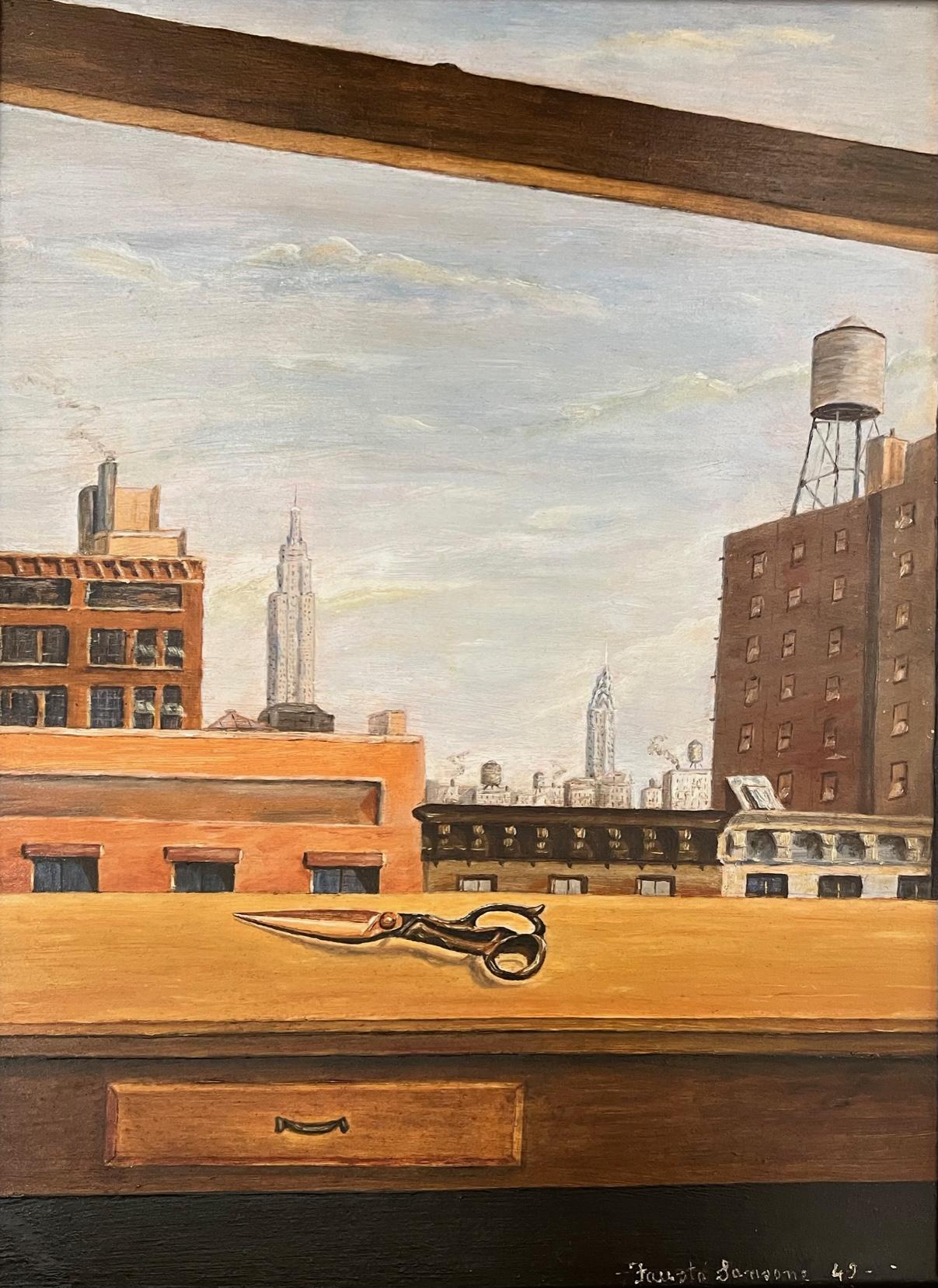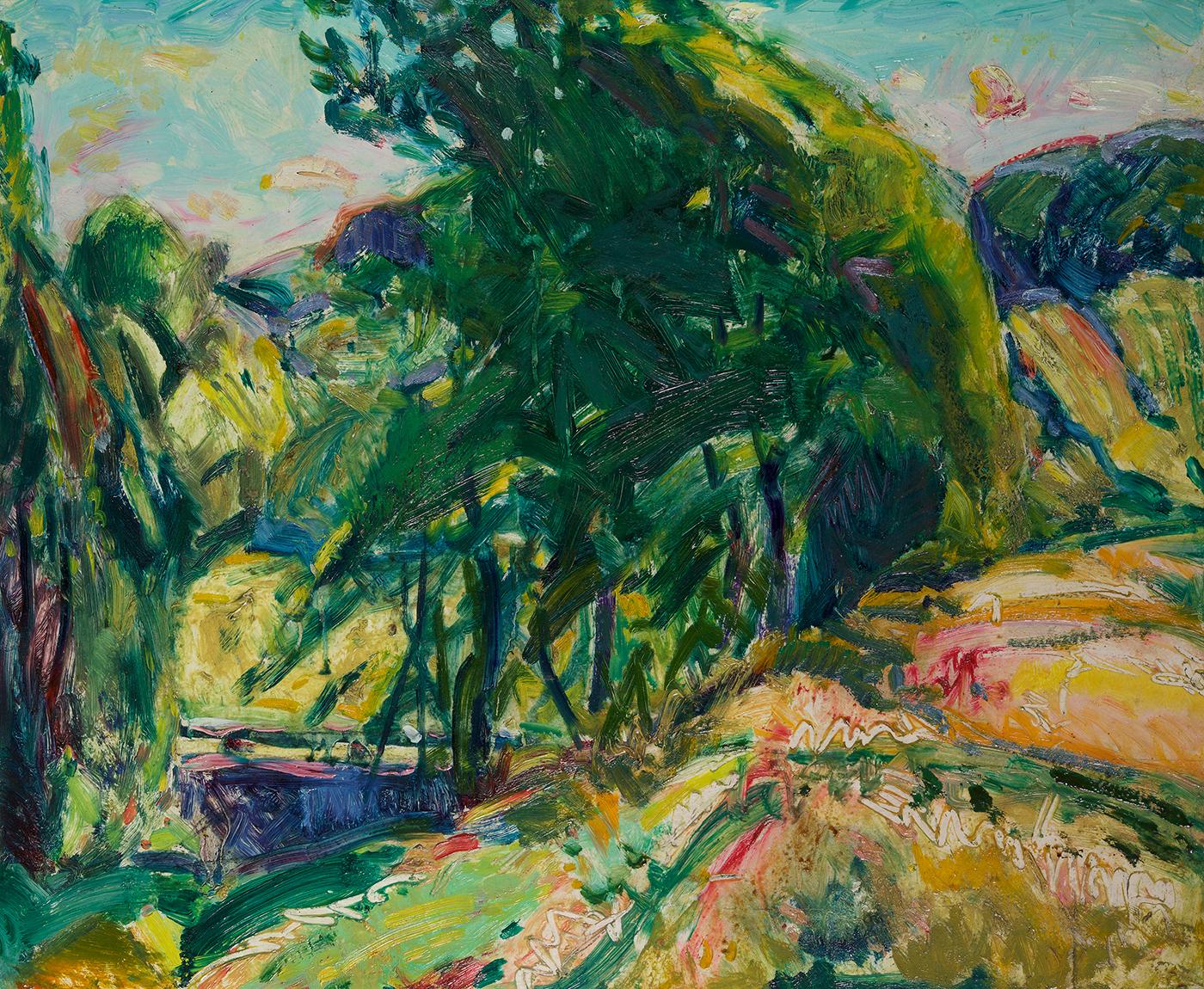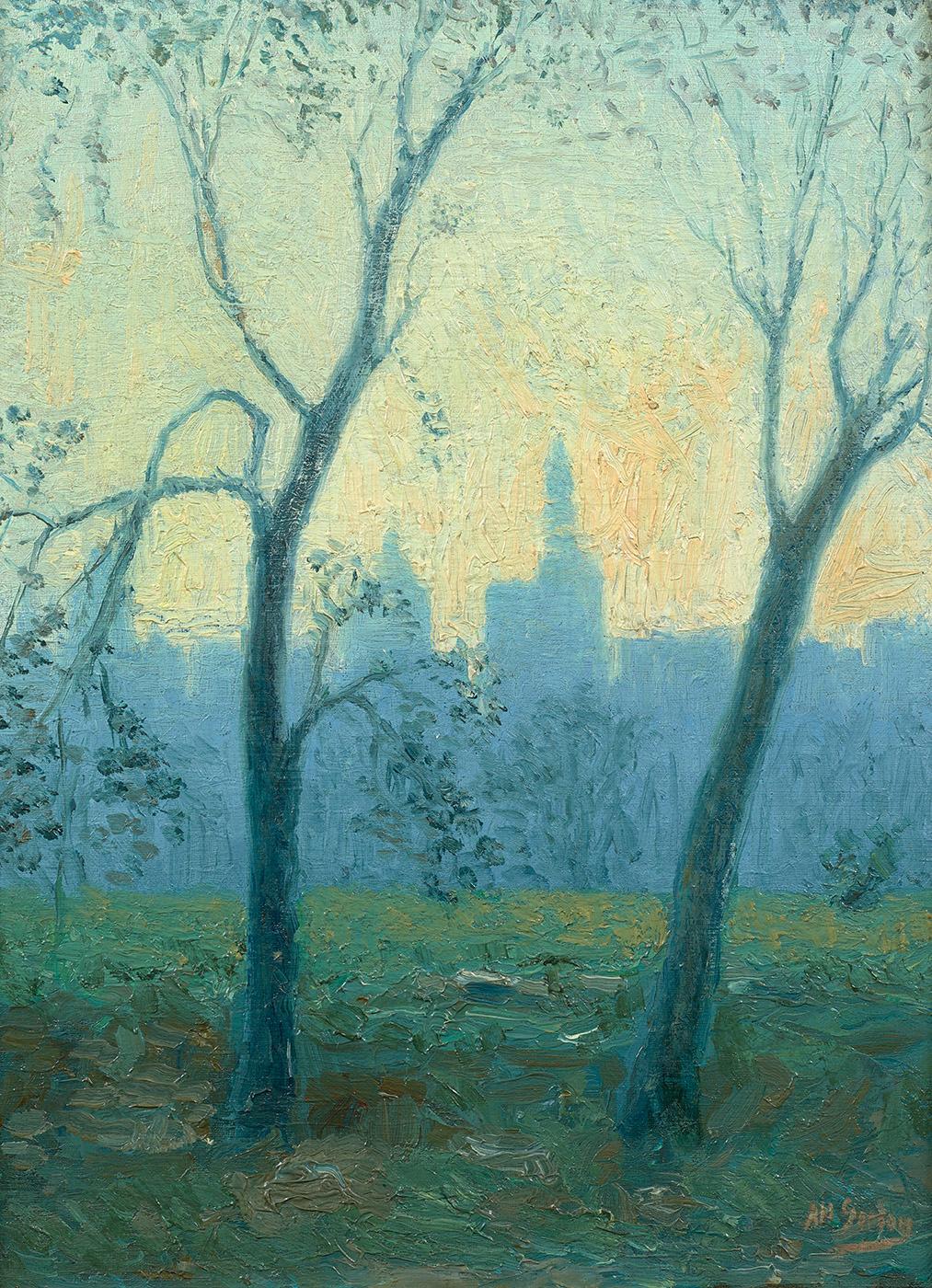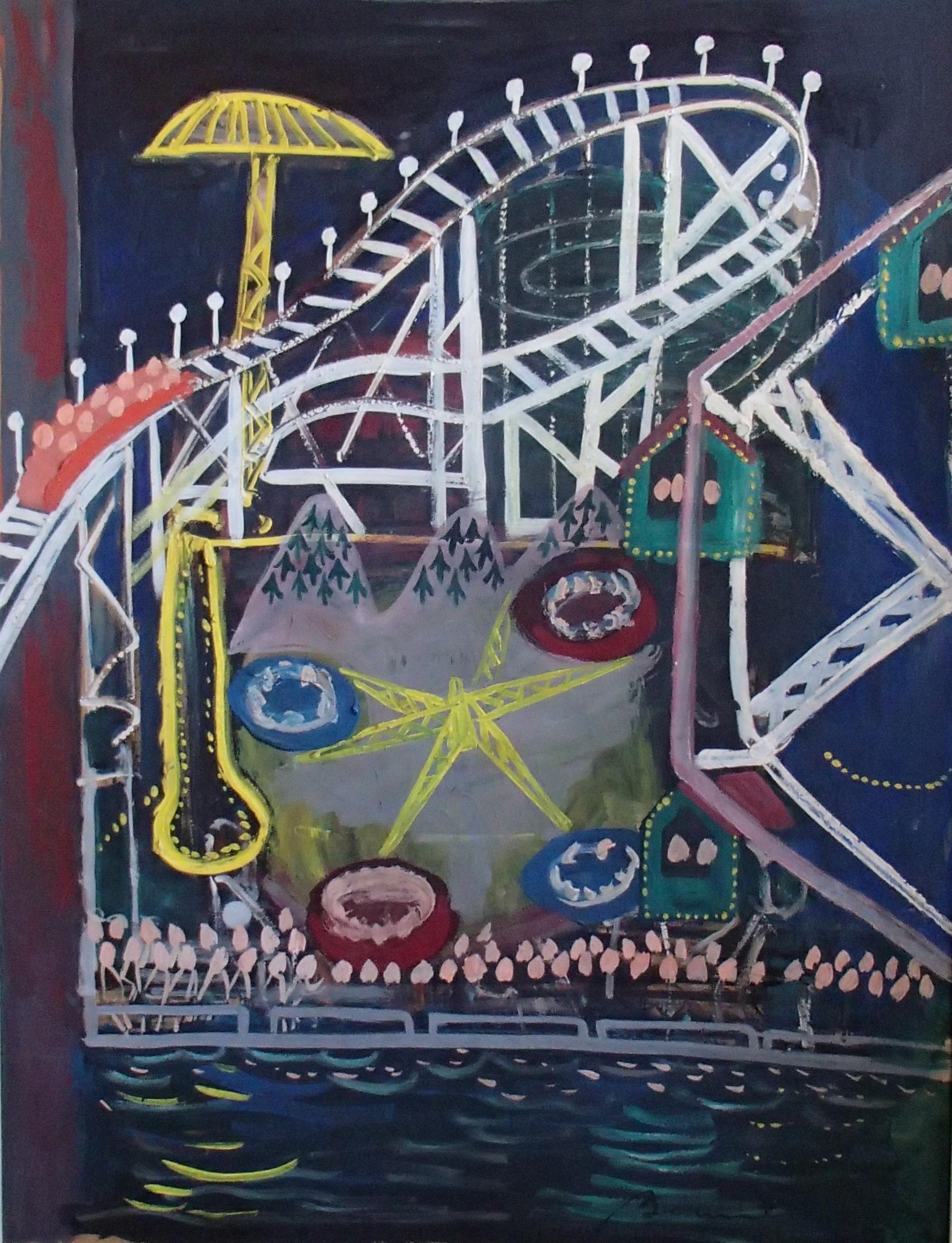Items Similar to Untitled (Houses and Railroad Tracks)
Want more images or videos?
Request additional images or videos from the seller
1 of 6
Harry LaneUntitled (Houses and Railroad Tracks)
About the Item
Untitled (Houses and Railroad Tracks), c. 1940s, oil on canvas board, signed lower right, 16 x 20 inches, presented in a newer frame
This work is part of our exhibition America Coast to Coast: Artists of the 1940s.
Harry Lane primarily worked in New York and the Berkshires. He is best known for his sleek, realistic still life paintings and urban and rural landscapes such as Untitled (House and Railroad Tracks). A native of New York City, Lane studied both in the United States and in Europe. While living in New York City, he frequently had solo shows including at the Ferargil, Kleeman, and Kennedy Galleries. He exhibited at the Pennsylvania Academy of Fine Arts, the Dallas Museum of Fine Art, the New York World’s Fair and the Society of Independent Artists. He worked for the Treasury Department’s Section of Fine Arts during the Great Depression, completing a 1937 mural for the Port Washington, New York Post Office and a 1939 mural entitled Air Express for the Oakdale, Louisiana post office. In 1949, he moved permanently to the Berkshires, acting for several years as Director of the Berkshire Art Center. He was a charter member and a former director of the Berkshire Art Association and was for several years a member of the Lenox Library Art Committee. Lane’s works are in the permanent collections of the Metropolitan Museum of Art (Hearn Fund Purchase), the Smithsonian American Art Museum, the Worcester Museum, the Museum of Fine Arts in Boston, the Museum of Fine Arts in Springfield, MA, and the Berkshire Museum in Pittsfield, MA. Lane's many awards include the Berkshire Art Association annual First Prize Award (1959), Silvermine Artist Guild's award for best oil (1960), Pittsfield Art League First Award for Oil (1951), a Conway Festival First Prize (1962), Albany Art Institute Regional Award (1963), Hillsdale, N.Y. Annual (1965) and First Prize Berkshire Art Association Spring Show (1968). He is listed in Who Was Who in American Art and other standard references.
- Creator:Harry Lane (1891 - 1973, American)
- Dimensions:Height: 16 in (40.64 cm)Width: 20 in (50.8 cm)Depth: 1 in (2.54 cm)
- More Editions & Sizes:16 x 20 inchesPrice: $4,000
- Medium:
- Movement & Style:
- Period:
- Condition:
- Gallery Location:Los Angeles, CA
- Reference Number:1stDibs: LU1859214250912
About the Seller
No Reviews Yet
Vetted Seller
These experienced sellers undergo a comprehensive evaluation by our team of in-house experts.
1stDibs seller since 2022
6 sales on 1stDibs
Typical response time: 8 hours
- ShippingRetrieving quote...Ships From: Los Angeles, CA
- Return PolicyA return for this item may be initiated within 3 days of delivery.
More From This SellerView All
- My Only Working ToolLocated in Los Angeles, CAMy Only Working Tool, 1949, oil on panel, signed and dated lower right, 16 x 12 inches, remnant of exhibition label verso, exhibited at the Art News Second Annual National Amateur Co...Category
1940s American Modern Paintings
MaterialsOil, Board
- Orange Grove LandscapeBy Dorr BothwellLocated in Los Angeles, CAOrange Grove Landscape, 1941, gouache on illustration board, 14 inches x 18 inches (image), 22 x 26 inches (framed) signed and dated lower right, newly framed with museum glazing ...Category
1940s American Modern Paintings
MaterialsGouache, Board
- Rabbit HuntersBy Roger MedearisLocated in Los Angeles, CARabbit Hunters, egg tempera on Masonite, 12 x 9 inches, 1947, signed and dated lower left, signed, titled and dated verso “Rabbit Hunters Egg Tempera Roger Medearis 1947,” exhibited ...Category
1940s American Modern Landscape Paintings
MaterialsTempera, Board
- Ponte Neuf (The Old Bridge)Located in Los Angeles, CA(Note: This work is part of our exhibition Connected by Creativity: WPA Era Works from the Collection of Leata and Edward Beatty Rowan) Oil on panel, 14 ½ x 18 inches unframed, 22 x 25 ½ inches framed, inscribed “painted by David McCosh Property of Edward b. Rowan” and numbered “8” verso Exhibited: The First Exhibit of the Iowa Artist...Category
1920s American Modern Landscape Paintings
MaterialsOil
- Six O'ClockLocated in Los Angeles, CASix O-Clock, c. 1942, oil on canvas, 30 x 20 inches, signed and titled several times verso of frame and stretcher (perhaps by another hand), marked “Rehn” several times on frame (for the Frank K. M. Rehn Galleries in New York City, who represented Craig at the time); Exhibited: 1) 18th Biennial Exhibition of Contemporary American Oil Paintings from March 21 to May 2, 1943 at The Corcoran Gallery of Art in Washington, D.C. #87, original price $450 (per catalog) (exhibition label verso), 2) Craig’s one-man show at the Frank K. M. Rehn Galleries, New York City, from October 26 to November 14, 1942, #10 (original price listed as $350); and 3) Exhibition of thirty paintings sponsored by the Harrisburg Art Association at the State Museum of Pennsylvania in Harrisburg in March, 1944 (concerning this exhibit, Penelope Redd of The Evening News (Harrisburg, Pennsylvania) wrote: “Other paintings that have overtones of superrealism inherent in the subjects include Tom Craig’s California nocturne, ‘Six O’Clock,’ two figures moving through the twilight . . . .” March 6, 1944, p. 13); another label verso from The Museum of Art of Toledo (Ohio): original frame: Provenance includes George Stern Gallery, Los Angeles, CA About the Painting Long before Chris Burden’s iconic installation outside of the Los Angeles County Museum of Art, Urban Light, another artist, Tom Craig, made Southern California streetlights the subject of one of his early 1940s paintings. Consisting of dozens of recycled streetlights from the 1920s and 1930s forming a classical colonnade at the museum’s entrance, Burden’s Urban Light has become a symbol of Los Angeles. For Burden, the streetlights represent what constitutes an advanced society, something “safe after dark and beautiful to behold.” It seems that Craig is playing on the same theme in Six O-Clock. Although we see two hunched figures trudging along the sidewalk at the end of a long day, the real stars of this painting are the streetlights which brighten the twilight and silhouette another iconic symbol of Los Angeles, the palm trees in the distance. Mountains in the background and the distant view of a suburban neighborhood join the streetlights and palm trees as classic subject matter for a California Scene painting, but Craig gives us a twist by depicting the scene not as a sun-drenched natural expanse. Rather, Craig uses thin layers of oil paint, mimicking the watercolor technique for which he is most famous, to show us the twinkling beauty of manmade light and the safety it affords. Although Southern California is a land of natural wonders, the interventions of humanity are already everywhere in Los Angeles and as one critic noted, the resulting painting has an air of “superrealism.” About the Artist Thomas Theodore Craig was a well-known fixture in the Southern California art scene. He was born in Upland California. Craig graduated with a degree in botany from Pomona College and studied painting at Pamona and the Chouinard Art School with Stanton MacDonald-Wright and Barse Miller among others. He became close friends with fellow artist Milford Zornes...Category
1940s American Modern Landscape Paintings
MaterialsCanvas, Oil
- LandscapeBy Marcel Emile CaillietLocated in Los Angeles, CALandscape, 1940, oil on canvas, 24 x 20 inches, signed, dated and titled verso: “Marcel Cailliet ’40 – S.C.” and “Marcel Cailliet Landscape”; likely exhibited at the annual juried st...Category
1940s American Modern Paintings
MaterialsCanvas, Oil
You May Also Like
- FRANKLIN Karl Mann Associates NY - Oil o/B - Brooklyn Bridge & Manhattan SkylineLocated in Meinisberg, CHFranklin for KARL MANN ASSOCIATES, New York (American, active in the 1960 's) The boarded up Brooklyn Bridge and the Manhattan Skyline - Oil on ...Category
1960s American Modern Landscape Paintings
MaterialsBoard, Oil
- Landscape with Green TreeBy Alfred Henry MaurerLocated in New York, NYAlfred Henry Maurer has been called the First American Modern because of his role in bringing modern methods of working to the United StatesCategory
Early 20th Century American Modern Landscape Paintings
MaterialsOil, Board
- The Break of the HazeBy Aaron Henry GorsonLocated in New York, NYSigned lower right: AH GorsonCategory
1920s American Modern Landscape Paintings
MaterialsCanvas, Oil, Board
- "Coney Island" Brooklyn NYC Amusement Park Mid-century American Scene WPA ModernBy Ludwig Bemelmans, 1898-1962Located in New York, NY"Coney Island" Brooklyn NYC Amusement Park Mid-century American Scene WPA Modern Ludwig Bemelmans (1898 – 1962), “Coney Island" 35 x 27 inches Oil on board Signed lower left Origin...Category
1940s American Modern Landscape Paintings
MaterialsOil, Board
- "Industrial Cityscape, Chicago" WPA Modernism Mid-Century Cityscape 20th CenturyBy Aaron BohrodLocated in New York, NYMidwestern Chicago artist Aaron Bohrod painted in 1931 this modernist industrial cityscape during the WPA of the 20th Century. Aaron Bohrod (American 1907 – 1992), Industrial Citysc...Category
1930s American Modern Landscape Paintings
MaterialsOil, Board
- Waiting for the Bus in a Blizzard- WPA American Scene 1938 NYC Modernism RealismBy Maurice KishLocated in New York, NYWaiting for the Bus in a Blizzard- WPA American Scene 1938 NYC Modernism Realism. 16 x 16 inches, Oil on board, Signed and dated 1938 lower left. ...Category
1930s American Modern Figurative Paintings
MaterialsOil, Board
Recently Viewed
View AllMore Ways To Browse
Gary Zack Vase
George Kozmon
Vintage Original Expressionist Art
Bill Howard
Namibia Canvas
Dune Grasses
Valentino Acrylic
Scott Wilson
Never Against Virginia
Bluebell Wood
Irish Princess
Mary Sims Artist
1940s Opera Glasses
Mexican Baroque Painting
Color Block Early 1900s
Victoria Harbor
Barneys Display
Guy Benard Painting





